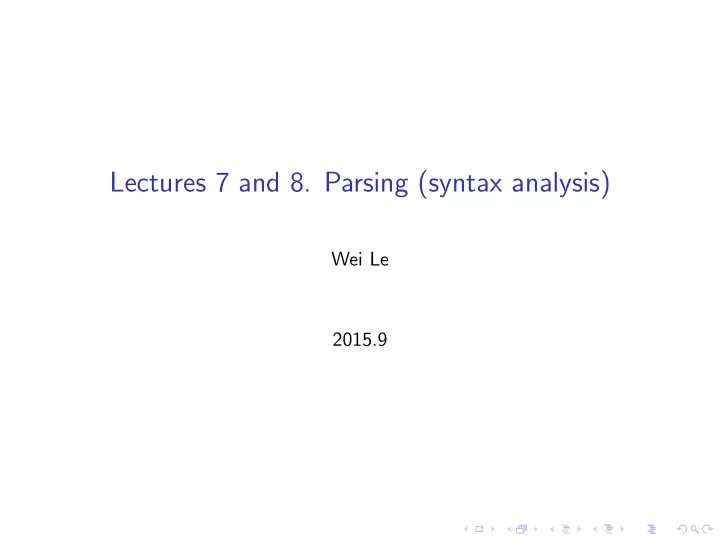

Lectures 7 and 8. Parsing (syntax analysis) Wei Le 2015.9
Bottom Up Parsing ◮ Recognize many programming languages, used in practice ◮ More general, more powerful parser: less restrictions on grammars, e.g., can handle left-recursive grammar ◮ no backtracking ◮ LR parsing: L – tokens are read from the left to right, R – rightmost derivation ◮ LR parsing reduces a string to the start symbol by inverting productions
LR Parsing
LR Parsing: An Example
LR Parsing: An Example
LR Parsing: An Example
LR Parsing: An Example
LR Parsing: An Example
LR Parsing: An Example
LR Parsing: Important Factor #1
LR Parsing: Where Reduction Happens
LR Parsing: Split Notation
LR Parsing: Shift and Reduce
Shift and Reduce Example
Shift and Reduce Example
Shift and Reduce Example
Shift and Reduce Example
Shift and Reduce Example
Shift and Reduce Example
Shift and Reduce Example
Shift and Reduce Example
Shift and Reduce Example
Shift and Reduce Example
Shift and Reduce Example
The stack
Key issues: when to shift or reduce
Key issues: when to shift or reduce
LR Parsing Algorithm
Parsing Table
Parsing Table
Table-Driven Bottom Up Parsing
LR Parsing Algorithm
Review: Key Ideas of LR Parsing
Review: Key Ideas of LR Parsing
How to Decide When to Shift or Reduce
How to Construct the Parsing Table Run stack on DFA: search which context matches the stack?
LR(1) Item Defines the State (or Context)
Notation Clarification
LR(1) Items Are Used to Define DFA
LR(1) Items Are Used to Define DFA: An Example
LR(1) Items Are Used to Define DFA: An Example
How To Determine a set of LR(1) Items for the State?
Closure Operation: An Example
Closure Operation: An Example
Closure Operation: An Example
LR(1) Items Are Used to Define DFA: An Example
LR(1) Items Are Used to Define DFA: Transitions
Automatically Generating Parsing Tables
Shift and Reduce Conflict
Shift and Reduce Conflict
Shift and Reduce Conflict
Shift and Reduce Conflict
Reduce Reduce Conflict
Reduce Reduce Conflict
Reduce Reduce Conflict
Motivation of LALR
Motivation of LALR
Motivation of LALR
LALR
LALR
LALR: Example
LALR
LALR
Parsing: A Summary ◮ Parse tree: how to derive a string from the grammar ◮ Context free grammars ◮ Algorithms: Recursive Decedent Parsers, LL (1), LR (1), LALR (1) ◮ General approach: table-driven parsing (the stack, streams of tokens, general parsing algorithm), using table to guide each step of building parsing trees ◮ Challenge: Building parsing table
Recommend
More recommend